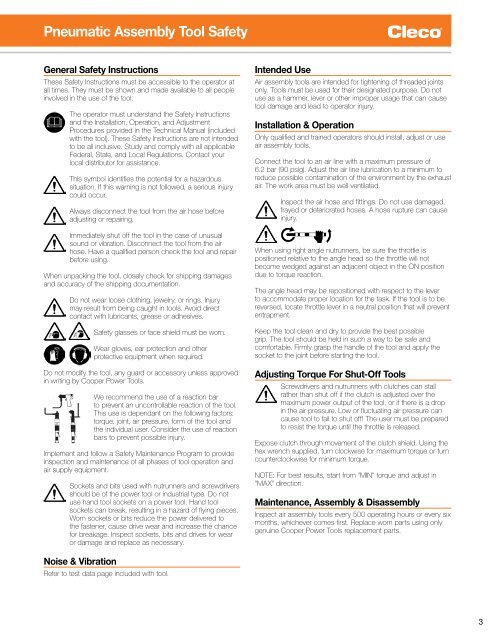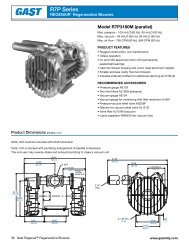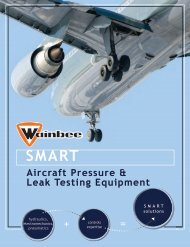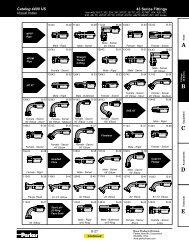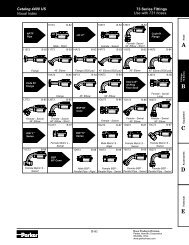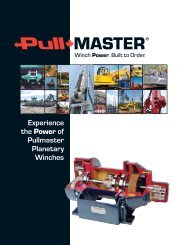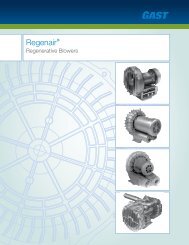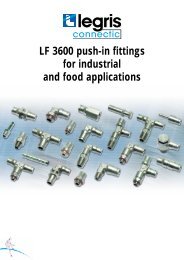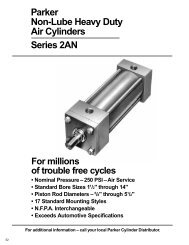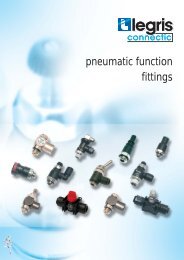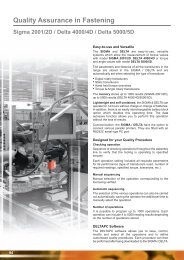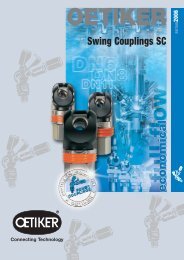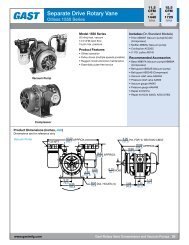Cleco Pneumatic Assembly Tools SP-1000 EN - Wainbee Limited
Cleco Pneumatic Assembly Tools SP-1000 EN - Wainbee Limited
Cleco Pneumatic Assembly Tools SP-1000 EN - Wainbee Limited
Create successful ePaper yourself
Turn your PDF publications into a flip-book with our unique Google optimized e-Paper software.
<strong>Pneumatic</strong> <strong>Assembly</strong> Tool Safety<br />
General Safety Instructions<br />
These Safety Instructions must be accessible to the operator at<br />
all times. They must be shown and made available to all people<br />
involved in the use of the tool.<br />
The operator must understand the Safety Instructions<br />
and the Installation, Operation, and Adjustment<br />
Procedures provided in the Technical Manual (included<br />
with the tool). These Safety Instructions are not intended<br />
to be all inclusive. Study and comply with all applicable<br />
Federal, State, and Local Regulations. Contact your<br />
local distributor for assistance.<br />
This symbol identifies the potential for a hazardous<br />
situation. If this warning is not followed, a serious injury<br />
could occur.<br />
Always disconnect the tool from the air hose before<br />
adjusting or repairing.<br />
Immediately shut off the tool in the case of unusual<br />
sound or vibration. Disconnect the tool from the air<br />
hose. Have a qualified person check the tool and repair<br />
before using.<br />
When unpacking the tool, closely check for shipping damages<br />
and accuracy of the shipping documentation.<br />
Do not wear loose clothing, jewelry, or rings. Injury<br />
may result from being caught in tools. Avoid direct<br />
contact with lubricants, grease or adhesives.<br />
Safety glasses or face shield must be worn.<br />
Wear gloves, ear protection and other<br />
protective equipment when required.<br />
Do not modify the tool, any guard or accessory unless approved<br />
in writing by Cooper Power <strong>Tools</strong>.<br />
We recommend the use of a reaction bar<br />
to prevent an uncontrollable reaction of the tool.<br />
This use is dependant on the following factors:<br />
torque, joint, air pressure, form of the tool and<br />
the individual user. Consider the use of reaction<br />
bars to prevent possible injury.<br />
Implement and follow a Safety Maintenance Program to provide<br />
inspection and maintenance of all phases of tool operation and<br />
air supply equipment.<br />
Sockets and bits used with nutrunners and screwdrivers<br />
should be of the power tool or industrial type. Do not<br />
use hand tool sockets on a power tool. Hand tool<br />
sockets can break, resulting in a hazard of flying pieces.<br />
Worn sockets or bits reduce the power delivered to<br />
the fastener, cause drive wear and increase the chance<br />
for breakage. Inspect sockets, bits and drives for wear<br />
or damage and replace as necessary.<br />
Intended Use<br />
Air assembly tools are intended for tightening of threaded joints<br />
only. <strong>Tools</strong> must be used for their designated purpose. Do not<br />
use as a hammer, lever or other improper usage that can cause<br />
tool damage and lead to operator injury.<br />
Installation & Operation<br />
Only qualified and trained operators should install, adjust or use<br />
air assembly tools.<br />
Connect the tool to an air line with a maximum pressure of<br />
6.2 bar (90 psig). Adjust the air line lubrication to a minimum to<br />
reduce possible contamination of the environment by the exhaust<br />
air. The work area must be well ventilated.<br />
Inspect the air hose and fittings. Do not use damaged,<br />
frayed or deteriorated hoses. A hose rupture can cause<br />
injury.<br />
When using right angle nutrunners, be sure the throttle is<br />
positioned relative to the angle head so the throttle will not<br />
become wedged against an adjacent object in the ON position<br />
due to torque reaction.<br />
The angle head may be repositioned with respect to the lever<br />
to accommodate proper location for the task. If the tool is to be<br />
reversed, locate throttle lever in a neutral position that will prevent<br />
entrapment.<br />
Keep the tool clean and dry to provide the best possible<br />
grip. The tool should be held in such a way to be safe and<br />
comfortable. Firmly grasp the handle of the tool and apply the<br />
socket to the joint before starting the tool.<br />
Adjusting Torque For Shut-Off <strong>Tools</strong><br />
Screwdrivers and nutrunners with clutches can stall<br />
rather than shut off if the clutch is adjusted over the<br />
maximum power output of the tool, or if there is a drop<br />
in the air pressure. Low or fluctuating air pressure can<br />
cause tool to fail to shut off! The user must be prepared<br />
to resist the torque until the throttle is released.<br />
Expose clutch through movement of the clutch shield. Using the<br />
hex wrench supplied, turn clockwise for maximum torque or turn<br />
counterclockwise for minimum torque.<br />
NOTE: For best results, start from "MIN" torque and adjust in<br />
"MAX" direction.<br />
Maintenance, <strong>Assembly</strong> & Disassembly<br />
Inspect air assembly tools every 500 operating hours or every six<br />
months, whichever comes first. Replace worn parts using only<br />
genuine Cooper Power <strong>Tools</strong> replacement parts.<br />
Noise & Vibration<br />
Refer to test data page included with tool.<br />
3


